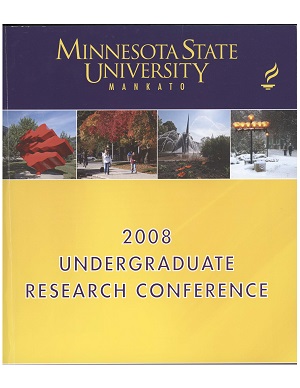Comparison of the Efficacy of Verbal and Pictorial Priming in the United States and Japan
Location
CSU 202
Start Date
22-4-2008 8:30 AM
End Date
22-4-2008 10:30 AM
Student's Major
Psychology
Student's College
Social and Behavioral Sciences
Mentor's Name
Vinai Norasakkunkit
Mentor's Department
Psychology
Mentor's College
Social and Behavioral Sciences
Description
The main topic of this study is cultural priming. Cultural priming is the experimental manipulation of an individual's way of thinking. The purpose of this study is to standardize a priming method that is equally effective for American (independent) and Japanese (interdependent) cultures. Sample size is estimated to be 100 participants, taken from MSU-Mankato and Kyoto Computer University in Japan. Subjects were primed for either independent (self oriented) or interdependent (relationship oriented) ways of thinking. Subjects were randomly assigned to one of four priming conditions: Picture Arrangement with Reading, Picture Arrangement Only, Verbal Priming, and a Control condition. Subjects were asked to complete the given priming procedure followed by three additional tasks to measure the priming effect. These tasks include an attitude test, a memory test, and a self-concept survey. The expected outcome of this study is that the Picture Arrangement with Reading will be the most effective priming procedure across both American and Japanese cultures. This is expected because the Picture Arrangement with Reading procedure includes verbal and visual stimulation accommodating to both American and Japanese culture's modes of cognition. Results will be discussed.
Comparison of the Efficacy of Verbal and Pictorial Priming in the United States and Japan
CSU 202
The main topic of this study is cultural priming. Cultural priming is the experimental manipulation of an individual's way of thinking. The purpose of this study is to standardize a priming method that is equally effective for American (independent) and Japanese (interdependent) cultures. Sample size is estimated to be 100 participants, taken from MSU-Mankato and Kyoto Computer University in Japan. Subjects were primed for either independent (self oriented) or interdependent (relationship oriented) ways of thinking. Subjects were randomly assigned to one of four priming conditions: Picture Arrangement with Reading, Picture Arrangement Only, Verbal Priming, and a Control condition. Subjects were asked to complete the given priming procedure followed by three additional tasks to measure the priming effect. These tasks include an attitude test, a memory test, and a self-concept survey. The expected outcome of this study is that the Picture Arrangement with Reading will be the most effective priming procedure across both American and Japanese cultures. This is expected because the Picture Arrangement with Reading procedure includes verbal and visual stimulation accommodating to both American and Japanese culture's modes of cognition. Results will be discussed.
Recommended Citation
Schmidt, Whitney Mone't. "Comparison of the Efficacy of Verbal and Pictorial Priming in the United States and Japan." Undergraduate Research Symposium, Mankato, MN, April 22, 2008.
https://cornerstone.lib.mnsu.edu/urs/2008/oral-session-09/7



